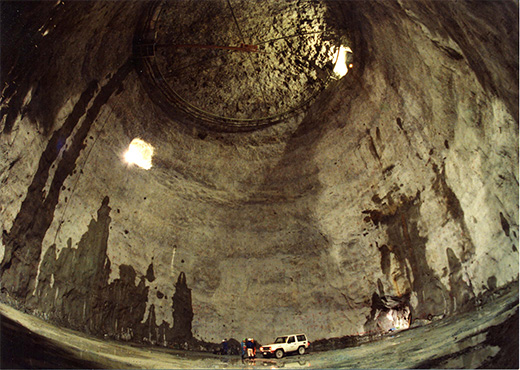
The vast underground chamber built by Mitsui Kinzoku to house Super-Kamiokande
Based on experiments conducted at Super-Kamiokande, installed 1,000m underground beneath Mitsui Kinzoku’s Kamioka Mine (Hida, Gifu prefecture), Professor Kajita discovered neutrino oscillation, proving that that neutrinos, one of the smallest subatomic particles, have mass. This is a major discovery that has overturned the accepted theory that neutrinos have no mass and brought us closer to unraveling the mysteries of how the universe was created, hence Professor Kajita being honored with the Nobel Prize in Physics in 2015.
Following on from the Kamiokande project carried out by the University of Tokyo Honorable Emeritus Professor Masatoshi Koshiba in 2002, Mitsui Kinzoku mining technology in the field of rock engineering once again played a part in Professor Kajita’s experiments at Super-Kamiokande. We take great pride and joy in that fact.
Super-Kamiokande is an observatory for monitoring neutrinos incoming from space. It houses a 41.1m high cylindrical tank measuring 39.3 m in diameter, inside which are over 10,000 photomultiplier tubes (PMT). Mitsui Kinzoku Group companies, including Kamioka Mining & Smelting Co. Ltd., built the vast underground chamber in which the observatory is located, some 1,000m beneath Kamioka Mine.
Our rock engineering capabilities are unrivalled by any other civil engineering or excavation company when it comes to efficiently excavating rock with no waste. Making the most of mining technologies built up over more than a century and our extensive expertise at Kamioka Mine, we designed this vast underground chamber so that it would be easy to maintain and manage over the long term. The excavation and support technologies that made this project possible in a short space of time and at minimal cost, whilst still ensuring high levels of safety, are dependent on an in-depth understanding of geological structural principles. Here at the Mitsui Kinzoku Group, we continue to monitor rock conditions in the area around the underground chamber, so that we can ensure the best possible environment for world-leading cutting-edge research to be carried out safely at all times.
As the geological structure of Kamioka mine consists of hard rock known as “Hida gneiss,” the underground chamber is stable and unaffected by the external environment. It is also has outstanding shielding and sound insulation properties, and is structurally sounds from the point of view of earthquakes too. It is thanks to these properties that world-leading cutting-edge research facilities such as Super-Kamiokande are being built underneath Kamioka Mine. In fact, there is thought to be considerable potential for research using underground spaces such as this in the future too.